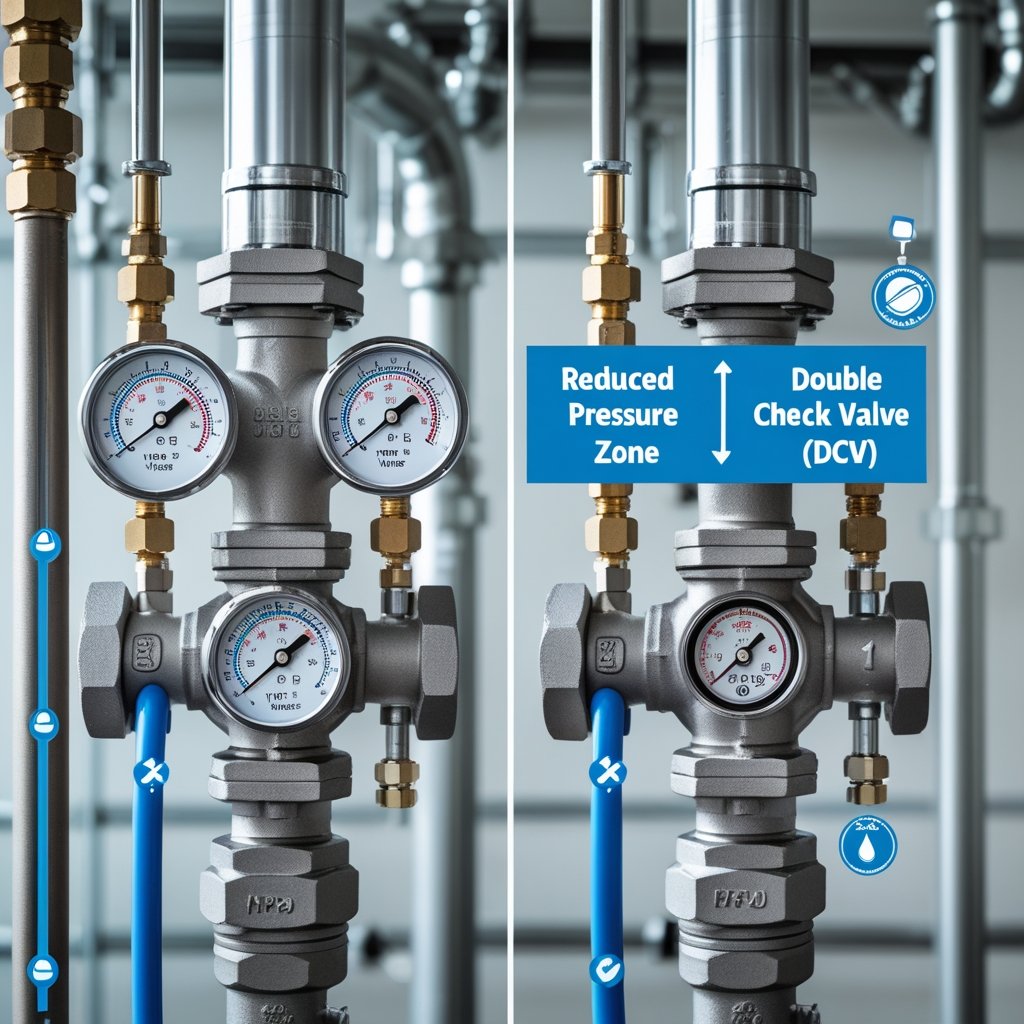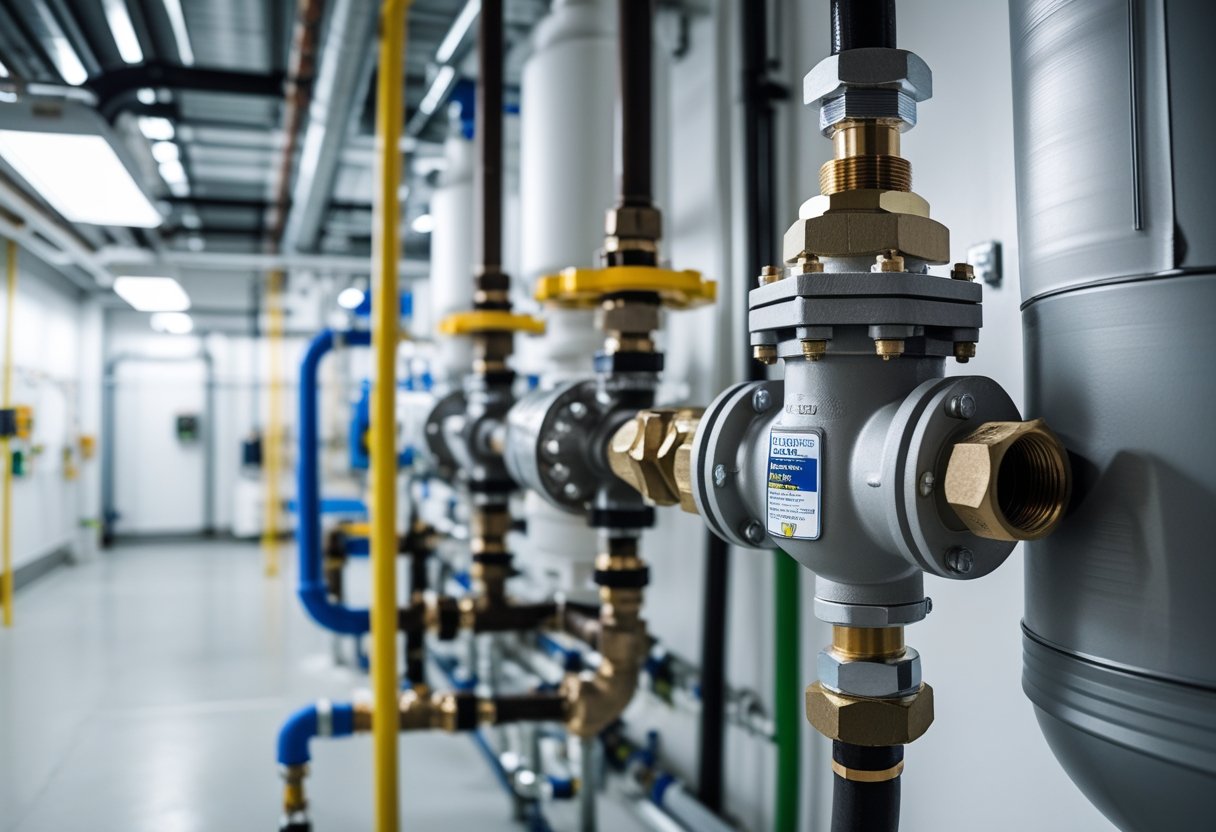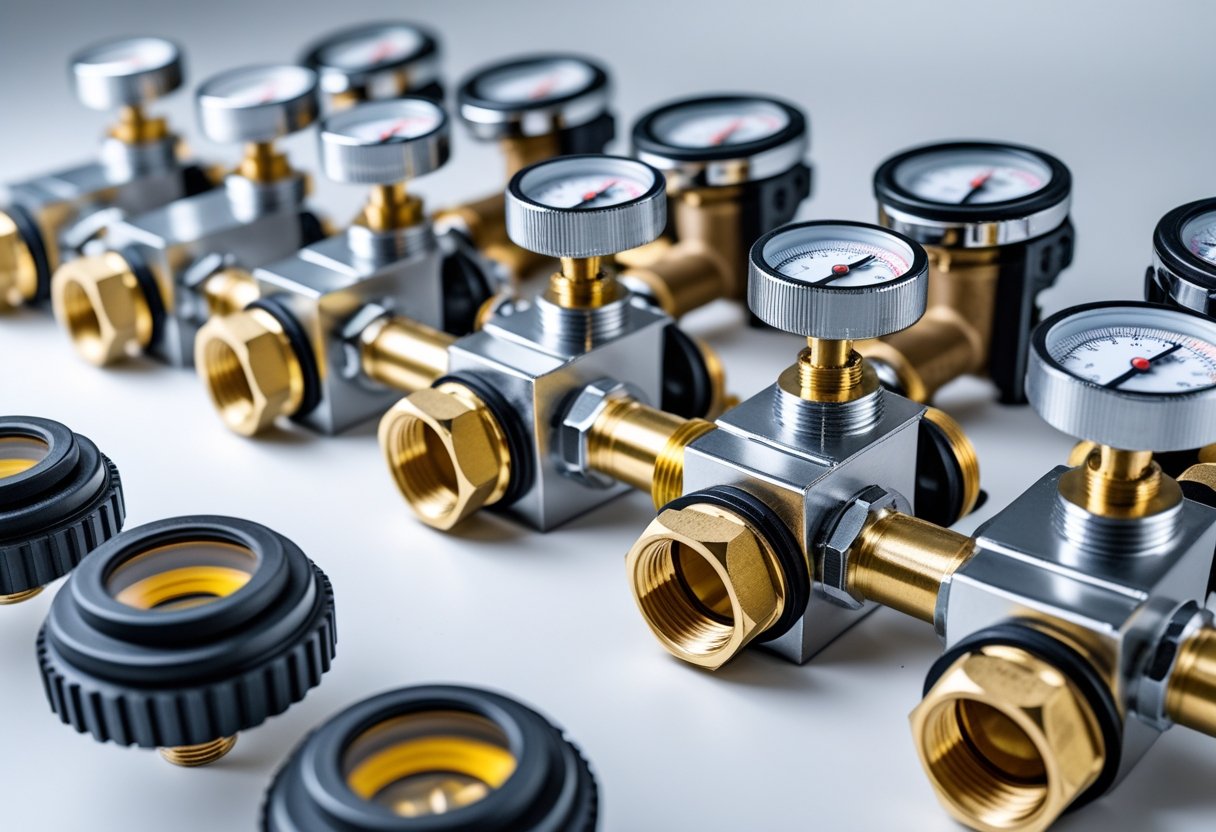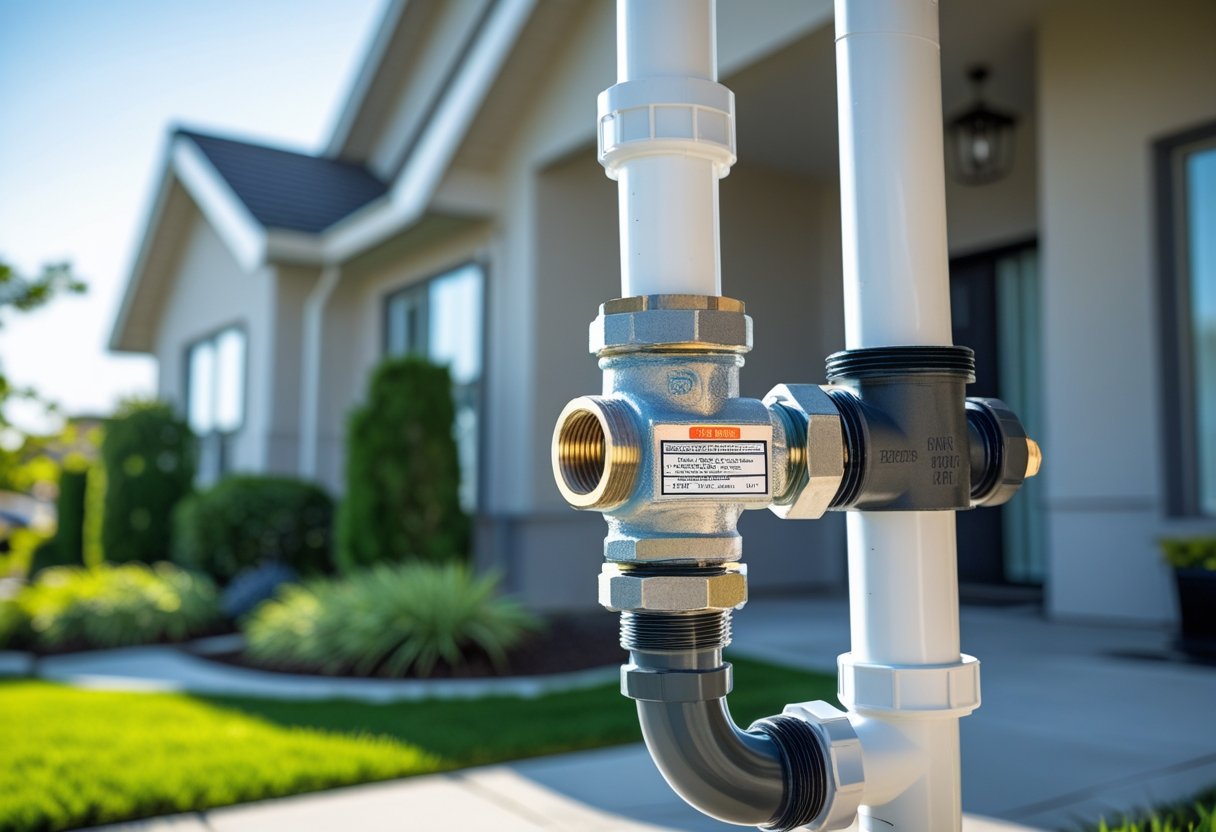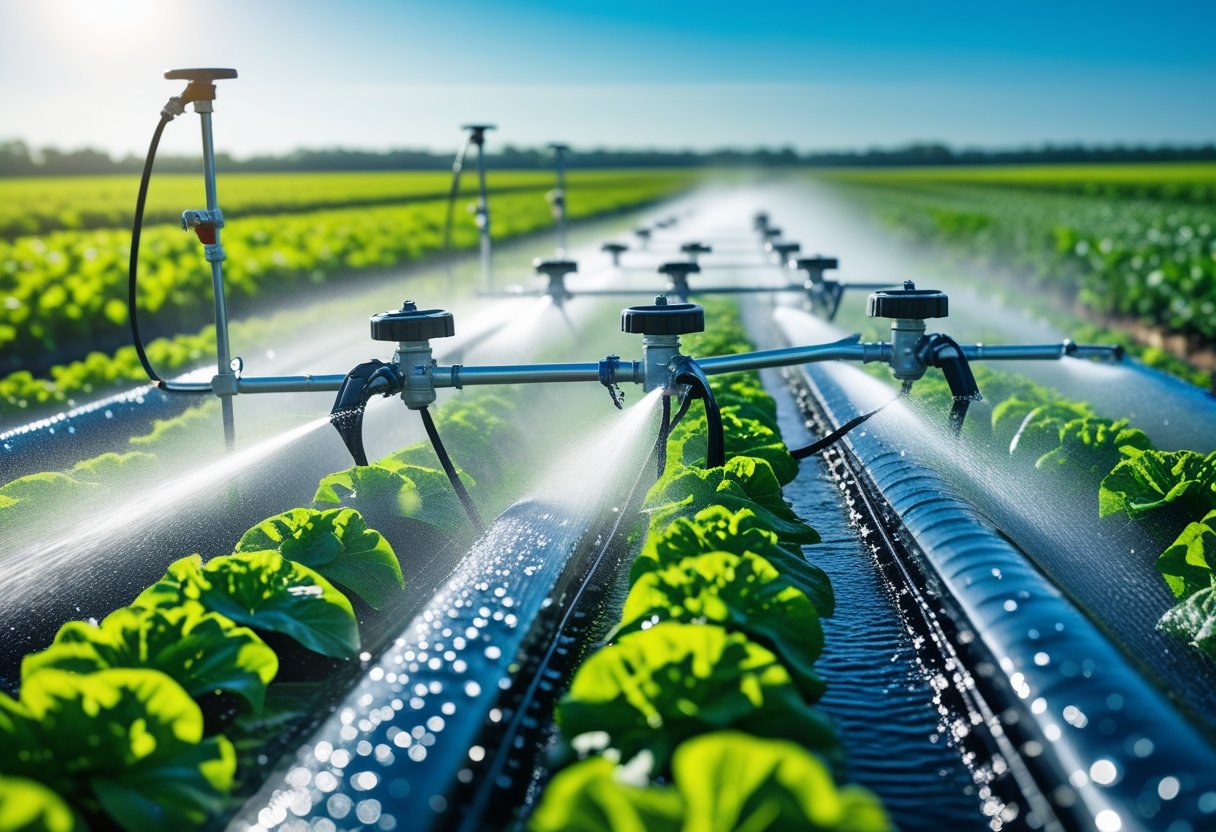When you want to protect your water supply from contamination, choosing the right backflow preventer is important. Two common types are the Reduced Pressure Zone (RPZ) device and the Double Check Valve Assembly (DCVA).
The main difference is that an RPZ offers a higher level of protection by using two check valves plus a pressure relief valve. A double check valve relies on just two check valves without the relief valve.
You might wonder why that matters. The RPZ works best in higher-risk situations where backflow contamination is a serious concern.
It keeps a special low-pressure zone between the two check valves. This allows any unsafe water to exit safely through a relief valve instead of flowing back.
A double check valve is usually enough for lower-risk conditions where contamination chances are smaller. It is a simpler device for general protection.
Overview of Reduced Pressure Zone and Double Check Valve
Both Reduced Pressure Zone (RPZ) and Double Check Valves help keep your water safe. They stop dirty water from flowing back into your clean water supply but work in different ways and suit different situations.
Definitions and Basic Concepts
A Double Check Valve uses two separate check valves inside one unit. These valves only let water flow in one direction.
If water tries to flow backward, the valves close to prevent contamination. This keeps your water supply cleaner.
An RPZ device also has two check valves but includes a special relief valve between them. This relief valve opens if water pressure gets too high on the backflow side.
This extra step offers stronger protection, especially where the risk of contamination is high. The RPZ is better for places where dangerous chemicals or pollutants could enter the system.
The Double Check Valve works well in places with less risk.
Historical Development
Double Check Valves have been used for many years as simple and effective backflow preventers. People like them because they are reliable and easy to maintain.
RPZ devices came later to provide higher safety. They became popular in areas with stricter rules or where water contamination could cause serious harm.
Today, both are approved by safety agencies but serve different needs.
Key Differences Between Reduced Pressure Zone and Double Check Valve
Understanding the differences between these two backflow preventers helps you choose the right one for your needs. They vary in design, how they work, and the level of protection they offer.
Design and Structure
The Reduced Pressure Zone (RPZ) has two check valves with a pressure relief valve between them. This relief valve opens to release water if pressure inside the zone rises and could cause backflow.
It also includes an air inlet valve that opens when water pressure drops. The RPZ must be installed above ground and protected from freezing because of its relief valve.
In contrast, the Double Check Valve (DCV) has two check valves but no relief valve or air inlet. It is simpler in design and relies on the two check valves to stop reverse flow without releasing water.
DCVs are more flexible in where you can install them.
Function and Purpose
Your RPZ assembly controls water flow with two check valves and uses the relief valve to actively prevent harmful backflow by releasing water when pressure gets unsafe. This makes it good for areas where contamination risk is high.
The Double Check Valve stops backflow by allowing water to flow only one way through two check valves. It offers protection but doesn’t have a relief valve, so it doesn’t release water to fix pressure problems.
Use the RPZ for high-risk situations. The DCV fits lower-risk areas with fewer potential contaminants.
Level of Protection
An RPZ gives you a higher level of safety because it creates a reduced pressure zone between the two check valves. The relief valve is ready to discharge if pressure rises.
This extra step helps prevent dangerous backflow in sensitive environments. The Double Check Valve protects water by stopping reverse flow with two valves but doesn’t provide an automatic way to relieve pressure buildup.
Use an RPZ when water supply contamination could harm health or safety. The DCV is suitable for general protection where fewer hazards exist.
Operation Mechanisms
Both devices stop water from flowing backward, but they use different methods. One relies on pressure differences and a relief valve, while the other uses two valves working in a series.
How a Reduced Pressure Zone Works
A reduced pressure zone (RPZ) device has two check valves and a pressure relief valve between them. When water flows in the right direction, both check valves open easily.
The area between the valves has lower pressure, which keeps the relief valve closed. If backflow happens, pressure in the middle zone drops.
This causes the relief valve to open and release water outside. It stops dirty water from flowing back into your clean water supply.
How a Double Check Valve Operates
A double check valve contains two check valves placed one after the other. Each valve allows water to flow in only one direction.
When water moves forward, both valves open. If water tries to flow back, both valves close to block the reverse flow.
Unlike an RPZ, it does not have a relief valve or pressure zone to drain water. This means it offers good protection but not as much as an RPZ in situations with a higher risk of contamination.
Double check valves are often used where the hazard is low or moderate.
Applications and Use Cases
Choosing the right backflow prevention device depends on where you plan to use it and the level of risk to your water supply. Some setups need stronger protection, while others work well with simpler devices for lower risk.
Commercial Installations
In commercial buildings, like factories, restaurants, or hospitals, you often need reduced pressure zone (RPZ) assemblies. These devices offer high-level protection by using two check valves and a relief valve that opens if pressure inside rises too much.
RPZ devices are necessary where chemicals, fertilizers, or other dangerous substances could contaminate the water. They must be installed above ground, kept from freezing, and regularly maintained.
Double check valves are less common in commercial settings because they offer lower protection. However, you can use them where the risk is minimal, such as irrigation systems or low-hazard equipment lines.
Residential Systems
For homes, double check valves are often enough. They provide two layers of protection to stop water from flowing backward and are easier to maintain and install.
RPZ assemblies are usually not needed for typical residential water lines unless your home has special equipment that increases risk. For example, if you have a home fire sprinkler system with chemical additives, an RPZ may be needed.
Both devices help protect your family’s drinking water. The double check valve is more common in regular households because of its simplicity and cost-effectiveness.
Installation Requirements
When you install either a Reduced Pressure Zone (RPZ) or a Double Check Valve (DCV), you must follow specific rules about where and how to place the device. You also need to follow local plumbing codes to make sure everything is safe and legal.
Placement Guidelines
Install your RPZ or Double Check Valve in a spot that is easy to reach for testing and maintenance. Both devices must be installed above ground, usually at least 12 inches off the floor to avoid flooding damage.
RPZ devices need a drain or relief opening nearby. This is because they automatically release water if pressure changes, so the water must flow safely away.
Double Check Valves do not need this drain but should still be placed away from potential contamination sources. Make sure there is enough clearance—often 12 inches on both sides—for testing and repairs.
Avoid areas exposed to freezing or extreme heat to protect device function.
Local Plumbing Codes
Your local plumbing codes set requirements about which backflow preventer you must use and how to install it. Some codes require RPZ devices for higher-risk water sources, like irrigation systems with fertilizer or chemical use.
Double Check Valves are usually allowed for lower-risk situations such as fire sprinkler systems. Always check with your city or water district before installing.
They may require permits or inspections, and they often want annual testing records on file. Use certified technicians for installation to make sure your device meets all code requirements.
Maintenance and Testing Procedures
You need to keep your backflow preventers in good shape with regular testing and quick fixes when needed. Knowing when to inspect and how to troubleshoot can save you from costly problems.
Inspection Frequency
Test your backflow preventer at least once a year. This is the rule in most areas to make sure it works correctly and follows local water authority laws.
For double check valves, annual testing confirms both check valves are sealing properly. Reduced pressure zone (RPZ) devices also need yearly checks to make sure the relief valve and check valves operate as they should.
If you notice leaks or irregular water pressure before your scheduled test, get it inspected right away. Regular inspections reduce the risk of contamination.
Common Troubleshooting Tips
If your backflow preventer fails a test, common problems often cause it. For RPZ devices, debris can block valves or cause the relief valve to stay open.
Stuck or broken valves and leaks around connections are usual issues. For double check valves, incorrect installation or failing to test ports can cause failures.
Dirt buildup can stop valves from closing fully, leading to backflow risks. To troubleshoot, clean any dirt or debris carefully.
Check for leaks or damaged parts. If repairs are needed, use certified professionals to replace or fix components to meet code and safety rules.
Advantages and Limitations
When you choose between a Reduced Pressure Zone (RPZ) and a Double Check Valve (DCV), it helps to know their strengths and limits.
RPZ advantages include stronger protection. The device has two check valves plus a pressure relief valve.
This setup lets it handle high-risk situations by stopping harmful water from flowing back into your clean water supply. However, RPZs must be installed above ground and need space for maintenance.
They are also more sensitive to freezing, so extra care is needed in cold areas. Double Check Valves are simpler and smaller.
They use two check valves that work together to stop backflow. This device is easy to install and works well for low to medium-risk situations.
A drawback of DCVs is they don’t have a relief valve. This means they provide less safeguard in places where water contamination risk is high.
FeatureRPZDouble Check Valve Backflow protection levelHigh (includes relief valve)Moderate (only check valves)InstallationAbove ground, requires spaceCan be installed in various locationsFreeze sensitivityYesLess sensitiveBest use caseHigh-risk, cross-connectionsLow to medium-risk
Selecting the Right Backflow Preventer
Choosing the best backflow preventer depends on your property's risk level and water safety needs.
If you need protection for a high-risk area, Reduced Pressure Zone (RPZ) devices are a strong choice. They use two check valves with a relief valve to stop contaminated water from flowing back into your clean water supply.
This makes RPZs ideal where the risk of contamination is higher.
For lower-risk situations, a Double Check Valve Assembly (DCVA) might be enough. It has two check valves but no relief valve.
This provides good protection for places where water contamination risks are lower.
Here’s a quick look at these options:
FeatureReduced Pressure Zone (RPZ)Double Check Valve Assembly (DCVA) Backflow ProtectionHighModerateCheck ValvesTwoTwoRelief ValveYesNoBest ForHigh-risk contamination areasLow-risk contamination areas
You should also think about your local codes and regulations. Some areas require specific devices, so check before selecting.
Regular testing and maintenance keep your system working and compliant with rules. Our certified technicians can help with testing, repairs, or installing the right backflow preventer for your property.
Industry Standards and Certification
Backflow prevention devices like Reduced Pressure Zone (RPZ) assemblies and Double Check Valve (DCV) assemblies must meet industry standards to keep your water safe.
Organizations like the American Water Works Association (AWWA) certify RPZ and Double Check Valve devices. These devices must comply with standards from groups such as the American Society of Sanitary Engineering (ASSE).
These certifications show the devices meet strict safety and performance guidelines.
Local water authorities require annual testing to keep your system compliant. Certified testers check for leaks, pressure changes, and proper operation of valves.
If a device fails, you need repairs or replacement to avoid contamination risks.
Certification TypePurposeApplies To ASSE 1013Standards for RPZ devicesRPZ AssembliesASSE 1015Standards for Double Check ValvesDouble Check AssembliesAnnual Backflow TestingVerifies device function and safetyBoth types
You can trust trained, certified pros to handle testing, repairs, and maintenance.
Frequently Asked Questions
Reduced pressure zone (RPZ) valves and double check valves work differently. They need different installation setups and fit certain situations better.
Maintenance needs and regulations also matter when choosing the right one for your system.
What are the key differences in functionality between an RPZ valve and a double check valve?
The RPZ valve has two check valves with a pressure relief valve in between. The relief valve discharges water if pressure gets too high.
This stops backflow completely, even in risky conditions.
A double check valve uses two check valves but does not have a relief valve. It prevents backflow but offers less protection than an RPZ, especially in hazards where contaminants could enter your water.
How do RPZ backflow preventers and double check valve backflow preventers differ in installation requirements?
RPZ valves must be installed above ground and protected from freezing. They also need enough space for maintenance and to allow the relief valve to drain water safely.
Double check valves are easier to install and can fit in tighter spaces. They don’t require special drainage or as much clearance.
Can you explain when one should use a reduced pressure zone backflow preventer over a double check valve?
Use an RPZ valve when there is a high risk of contamination, such as chemical or bacterial hazards. It’s the better choice when you need maximum protection.
A double check valve is suitable for low to medium hazard conditions, where risks of dangerous backflow are smaller.
What are the maintenance considerations for RPZ backflow preventers compared to double check valve assemblies?
RPZ valves require regular checks to ensure the relief valve works properly and the device is clear of debris. You must keep the area dry and frost-free.
Double check valves need less maintenance but should still be tested yearly. They have fewer moving parts and no relief valve to worry about.
Why might a reduced pressure zone be necessary in some plumbing systems instead of a double check valve?
An RPZ is necessary when the water system faces potential backflow contamination that could harm health or safety. It prevents both backflow and back-siphonage with extra safeguards.
Double check valves are not strong enough to protect against all types of contamination that might enter your water supply in these situations.
What scenarios require the use of an RPZ valve for backflow prevention rather than a double check valve?
You must use an RPZ in systems connected to hazardous materials, such as chemicals in irrigation. Fire sprinkler systems or industrial uses also require RPZ valves.
Local codes often require RPZ valves for certain high-risk water lines. Contamination in these lines would pose a serious threat to public health.

